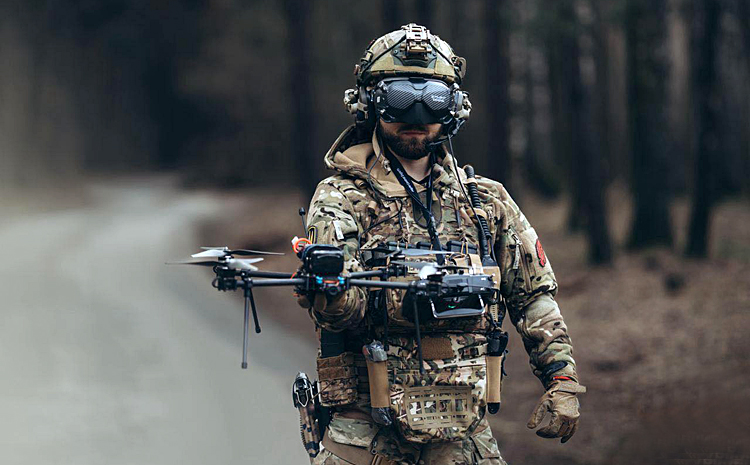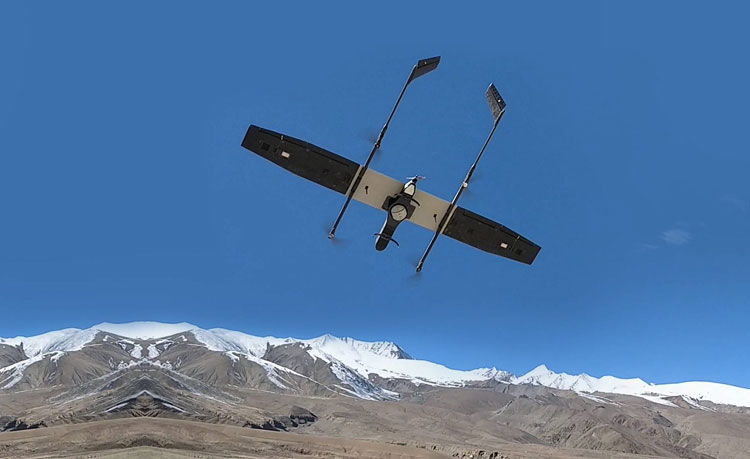INDIAN ARMED FORCES CHIEFS ON OUR RELENTLESS AND FOCUSED PUBLISHING EFFORTS

The insightful articles, inspiring narrations and analytical perspectives presented by the Editorial Team, establish an alluring connect with the reader. My compliments and best wishes to SP Guide Publications.

"Over the past 60 years, the growth of SP Guide Publications has mirrored the rising stature of Indian Navy. Its well-researched and informative magazines on Defence and Aerospace sector have served to shape an educated opinion of our military personnel, policy makers and the public alike. I wish SP's Publication team continued success, fair winds and following seas in all future endeavour!"

Since, its inception in 1964, SP Guide Publications has consistently demonstrated commitment to high-quality journalism in the aerospace and defence sectors, earning a well-deserved reputation as Asia's largest media house in this domain. I wish SP Guide Publications continued success in its pursuit of excellence.
- Operation Sindoor: Resolute yet Restrained
- India’s Operation Sindoor Sends a Clear Message to Terror and the World – ‘ZERO TOLERANCE’
- Japan and India set forth a defence cooperation consultancy framework, talks on tank and jet engines
- Terrorist Attack in Pahalgam in Kashmir: Unfolding a long surgical war against PAK
- Lt General Pratik Sharma takes over Command of Indian Army's Northern Command
FPV Platoons in Infantry Battalions
The Indian Army is planning to raise a First Person View (FPV) drones platoon within each infantry battalion in adapting to modern warfare; to upgrade tactical combat capabilities of reconnaissance, surveillance and precision strikes
 |
The Author is Former Director General of Information Systems and A Special Forces Veteran, Indian Army |

The recent article 'Reign of Drones' in these columns covered how Ukraine's Operation 'Spider's Web' demonstrated rapid advances in technology and innovative thinking; highlighting how low-cost, improvised unmanned drones can be employed with strategic impact deep behind enemy lines – bringing a strategic dimension to drone warfare. The highly effective use of drones in Operation 'Sindoor' was also covered, as well as India's plans to spend up to $470 million on UAVs in next 12-24 months (three times pre-conflict levels), need to develop AI-driven advanced robots and drones, and be fully geared to combat drone threats from across the borders and from within India.
It has now also emerged that on the night of July 1-2, 2025, Ukraine carried out a precision attack on components of the Russian 'Nebo-M' radar system in the Crimean Peninsula, using heavy bomber drones (each heavy drone is armed with three bombs) launched from Unmanned Surface Vessels (USVs), or drone carrying boats. Ukraine introduced sea drones early in the ongoing conflict to counter Russian dominance of the Black Sea Fleet, and has continued to improvise and innovate since, releasing First Person View (FPV) drones from these drone boats in March 2025 to hit Russian air defence systems and surface-to-air missiles.
There are calls for India to establish a 'Unified Drone Command', given the demonstrated centricity of drones in both offensive and defensive operations, as part of asymmetric operations in Ukraine
According to news reports of June 28, 2025, The Indian Army is planning to raise an FPV platoon within each infantry battalion in adapting to modern warfare; to upgrade tactical combat capabilities of reconnaissance, surveillance and precision strikes. Each FPV platoon is likely to comprise 20-30 persons; it is expected to include trained drone operators, technicians and support staff. These sub-units will operate alongside the existing Ghatak Platoon (for specialised tasks) of the infantry battalion. With over 350 infantry battalions, the infantry forms the backbone of the Army; equipping each infantry battalion with an FPV platoon would significantly enhance its combat effectiveness. This move comes at a time when drone warfare is proving transformative in conflict both at the tactical and strategic levels as seen in the war in Ukraine, where FPV drones are being used extensively for defensive and offensive operations.

FPV drones are compact, agile, and capable of navigating complex terrains, making them ideal for urban combat, counter-insurgency and border security missions. They operate via a first-person perspective through real-time video feeds, offer soldiers enhanced situational awareness and the ability to engage targets from a safe distance. The proposed FPV platoons in infantry battalions are expected to undertake a range of operations, including: Real-Time Reconnaissance – providing live imagery of enemy positions, terrain and potential threats to enable commanders making informed decisions; Surveillance and Monitoring – conducting persistent surveillance of sensitive areas, particularly along contested borders with Pakistan and China; Precision Strikes – delivering small payloads of like explosives or grenades to neutralise high-value targets or fortified positions; Force Protection – detecting improvised explosive devices and ambushes, reducing the risks to the lives of the soldiers.
China has already deployed drone swarms in Eastern Ladakh, while Pakistan has used drones for surveillance, arms smuggling, and even direct attacks on Indian airbases
Concurrently, there are calls in the media for India to establish a 'Unified Drone Command', given the demonstrated centricity of drones in both offensive and defensive operations, as part of asymmetric operations in Ukraine. Looking at the growing China-Pakistan-Bangladesh nexus and potential drone threats from within India, this is considered essential, especially since China and Pakistan are rapidly integrating drones into their military doctrines and China and Turkey are supplying drones to Bangladesh. China has already deployed drone swarms in Eastern Ladakh, while Pakistan has used drones for surveillance, arms smuggling, and even direct attacks on Indian airbases.
A dedicated Unmanned Systems Command (IN-USC) under the Chief of Defence Staff (CDS) would enable: Offensive Operations - deploying Unmanned Combat Aerial Vehicles (UCAVs), loitering munitions, and FPV drones for direct action and support; Intelligence, Surveillance and Reconnaissance (ISR) - operating long-range and high-altitude drones for border monitoring, strike planning, and maritime awareness; Counter-Drone Systems integrating electronic warfare (EW) teams, laser-based interceptors, and radar jamming units to defend critical infrastructure. A Drone Warfare Academy is also recommended to train combat drone pilots, AI swarm tacticians, and electronic warfare specialists.

Building indigenous capability at scale is equally vital. Companies like ideaForge, Tata Advanced Systems, and NewSpace are emerging leaders, but the focus must shift to mass-producing low-cost FPV and swarm drones, developing stealthy autonomous UCAVs and fielding advanced anti-drone systems and laser interceptors. A capital outlay of ₹50,000 crore over five years is proposed to procure 10,000+ drones, build 100+ hardened shelters, and create training simulators, forward drone bases, and warfare labs. In what period 10,000+ drones are proposed to be procured is not mentioned. However, it must be kept in mind that Ukraine is reportedly expending 10,000 drones every month and a Chinese drone manufactured (who is not the only drone manufacture in China) has disclosed a substantial government order for approximately one million lightweight kamikaze drones, with delivery expected by 2026.
A Drone Warfare Academy is also recommended to train combat drone pilots, AI swarm tacticians, and electronic warfare specialists
But in addition to the large number of drones, specialised cadre, FPV platoons, a dedicated Unmanned Systems Command (IN-USC) under the Chief of Defence Staff, and a Drone Warfare Academy, India needs a more focused approach for developing requisite drone capability. According to veteran Major General M. Indrabalan, Military Tech Advisor at Chennai-based drone startup 'Amber Wings', India demonstrated drone warfare capabilities during Operation 'Sindoor', but the underlying technology still heavily relies on foreign systems.

Speaking to the media, Indrabalan pointed out that the majority of drones deployed during the operation were assembled and not fully indigenised, with critical electronic components sourced from abroad. He said the operation exposed critical gaps in India's drone technology stack. "The drone has its aerodynamics, its airframe, its propellers - but the main point of the drone is its brain: the autopilot or control system, the navigation system, the telemetry. Now these are the things - we have realised during Op Sindoor - need extreme focus. In terms of our ability to match world-level technologies, or even what China uses, we are way, way behind. A lot of catching up to do." He warned that reliance on foreign navigation and transmission systems makes Indian drones vulnerable to spoofing, jamming, and cyber-attacks. An Indo-American suggests that maybe this is one area IITs can take the lead to develop/prototype fully indigenous drone systems, with each IIT becoming a nodal drone authority, for example IIT Mumbai for the Navy, IIT Delhi for the Army, IIT Madras for the Air Force, and the like.
A capital outlay of ₹50,000 crore over five years is proposed to procure 10,000+ drones, build 100+ hardened shelters, and create training simulators, forward drone bases, and warfare labs
In his article in the 'Strategic Perspectives Foundations', Pavithran Rajan writes that the future of warfare lies in the seamless, AI-orchestrated integration of forces across air, land, sea, space, and cyberspace; in this networked environment, calculus of military power shifts dramatically, especially when comparing manned and unmanned platforms. Manned forces will lose strategic dominance, yielding to distributed, networked intelligence of autonomous systems. Adding hypersonic missiles to this makes it a fundamental redefinition of military power.
According to news reports of July 8, 2025, South Korea has cancelled plans to buy 36 x AH-64 Apache helicopters. Yu Yong-weon, member of South Korea's National Assembly, told media: "Drones and smart systems are redefining modern battlefields… Rather than clinging to expensive legacy platforms, we must invest in capabilities that reflect the future of warfare." Indian policy makers must examine these issues in order to effectively counter the mounting threats to India's national security.





